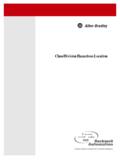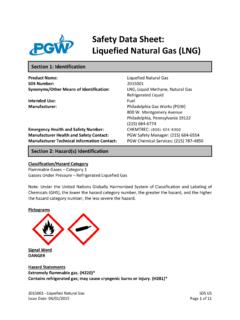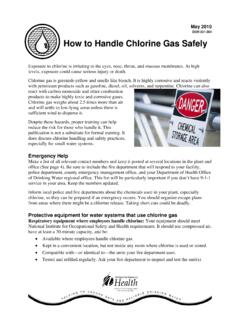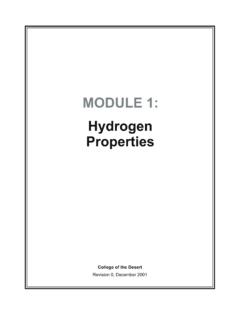Transcription of Wood dust: Controlling the risks WIS23 - HSE
1 Health and Safety Executive Wood dust Controlling the risks HSE information sheet Woodworking Sheet No 23 (Revision 1). Introduction Safety risks Wood dust is flammable and, in certain situations, can This information sheet is one of a series produced cause a fire or Every year, premises are by HSE's manufacturing sector on wood ,2,3 severely damaged or destroyed by wood dust fires It provides advice for woodworking employers. It that usually start in dust extraction equipment. Wood explains what the health and safety risks from wood dust explosions in buildings are rare, except in the dust are and how they can be controlled. It will also chipboard industry.
2 Help employers to ask the right questions when dealing with local exhaust ventilation (LEV) designers It also makes sense to control wood dust from a and suppliers. business point of view as you will need less time for clearing up, and there will be fewer slips and trips hazards caused by settled dust. Types of wood dust In addition to the tiny particles of wood produced What causes high wood dust exposures? during processing, wood dust can also contain bacteria and fungal and moss spores. The quantity The following activities are likely to produce high dust and type of wood dust will depend on the wood being exposures, some over long periods: cut and the machine you are using, for example: machining operations, particularly sawing, routing whether the timber is green or seasoned; and turning.
3 Whether it is a hardwood, softwood or composite sanding, by machine and by hand;. board; using compressed airlines to blow dust off furniture how aggressive the machine cutter or blade and other articles (to be avoided) before spraying;. profile is. hand assembly of machined or sanded components;. The biggest risk is from fine dust, as you can breathe operations involving processing composite boards, this deep into your lungs where it will do the most eg medium-density fibreboard (MDF);. damage. Fine dust will also spread further from the the bagging of dust from dust extraction systems;. cutting process so it is important to clean ledges and housekeeping, especially if sweeping up and using other workroom surfaces regularly to prevent dust compressed airlines (again to be avoided).
4 Accumulating. What the law says Why is it necessary to control wood dust? Because of the potential health problems, wood dust is covered by the Control of Substances Hazardous Health risks to Health Regulations (COSHH).4 These set out the Wood dust is a substance hazardous to health legal requirements to protect workers from health risks because it can cause serious non-reversible health arising from hazardous substances at work. Under problems,2 including: COSHH, employers (including contractors) have a duty to carry out a suitable and sufficient risk assessment skin disorders; and take steps to ensure they prevent or adequately obstruction in the nose, and rhinitis; control exposure.
5 Asthma;. a rare type of nasal cancer. COSHH states that, where it is not reasonably practicable to prevent exposure to a hazardous 1 of 7 pages Health and Safety Executive substance, control of that exposure should only be the crown guard hood of a circular saw by adding a treated as adequate if: spigot, as detailed in Figure 1. This improvement to the VFR will remove the dusty air in the hood more the principles of good practice for the efficiently so there will be less chance of leakage' of control of exposure are applied. This is set dusty air into the workroom. out in Schedule 2A to the COSHH Regulations and includes the requirement to provide suitable You might need to use RPE as a temporary measure personal protective equipment, such as respiratory to control exposure where engineering controls are protective equipment (RPE), combined with your being developed or modified.
6 You may also need RPE. other control measures, such as LEV, if adequate for additional protection for short-term jobs such as control cannot be achieved; cleaning and maintenance that produce high levels any workplace exposure limit (WEL) is not of dust. exceeded. Both hardwood and softwood dusts have a WEL of 5 mg/m3. These are limits placed When cleaning up, use vacuum equipment that on the amount of dust in the air, averaged over an meets at least the dust class M (medium hazard). eight-hour working day; classification. Do not use compressed airlines or hand for a substance that has the potential to brushing, particularly on clothing, as these will just cause cancer or occupational asthma (such create dust clouds and redistribute the dust.)
7 As wood dust) exposure is reduced to as low a level as is reasonably practicable (ALARP). This means that, even if your control measures (eg LEV) reduce exposure to below the WEL, but there remain improvements that could further reduce the exposure, then you should make these improvements if reasonable and practicable. In all cases, employers should consult their workers or their representatives when assessing risks and making decisions about control measures. Good communication and co-operation are essential if control measures are to be accepted and adopted by the workforce. How do I control wood dust exposure? Figure 1 Improving volume flow rate on crown guards The best way for you to do this is to use fixed LEV.
8 That will effectively control the dust at source as it is LEV design and management produced. In some cases, the hood(s) used to capture the dust can be part of the machine housing or In addition to capturing the fine wood dust, the design guards, such as the crown guard shown in Figure 1. of the LEV system should also allow it to take away the larger/heavier chips and shavings. LEV systems Fine wood dust becomes suspended in air and may look simple but there's a lot more to them than capturing the dust is all about Controlling the a fan and some ductwork. To get the best from your movement of this dusty air. This can be difficult LEV you must understand: as the high-speed rotating blades and cutters of woodworking machines act like fans and generate the particular requirements of LEV systems used in strong air movements.
9 Woodworking;. the basic design principles;. The job of the LEV system is to contain this air how to check that your LEV is working properly. movement and with it the dust. Many LEV designs fail to do this because the hood design is wrong (for The woodworking industry is unusual in that often the more information, see chapter 6 of HSG2585). Hoods LEV extracts from different combinations of machines should be designed to contain, receive and control at different times. As the airflows through the hoods these air movements and there are some simple rules- are not fixed, the LEV system cannot be balanced'. of-thumb that you can use to create the most effective Balancing means getting the airflow needed to control and efficient LEV hoods.
10 An example of one simple the wood-dust cloud at every hood in the system after improvement to improve the volume flow rate (VFR) first installation. This is achieved by determining the is to increase the diameter of the extract point from various airflows in each branch, hood resistance 2 of 7 pages Health and Safety Executive Having one fan and filter system that supplies suction doors so you can check for and clear blockages. to a number of machines means that: The LEV system should be designed to supply the system should be designed to run the the correct VFRs. These will vary for each type of maximum number of machines that will be used woodworking machine, but it is important that they are at any one time.

















